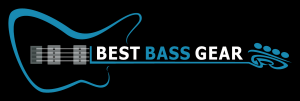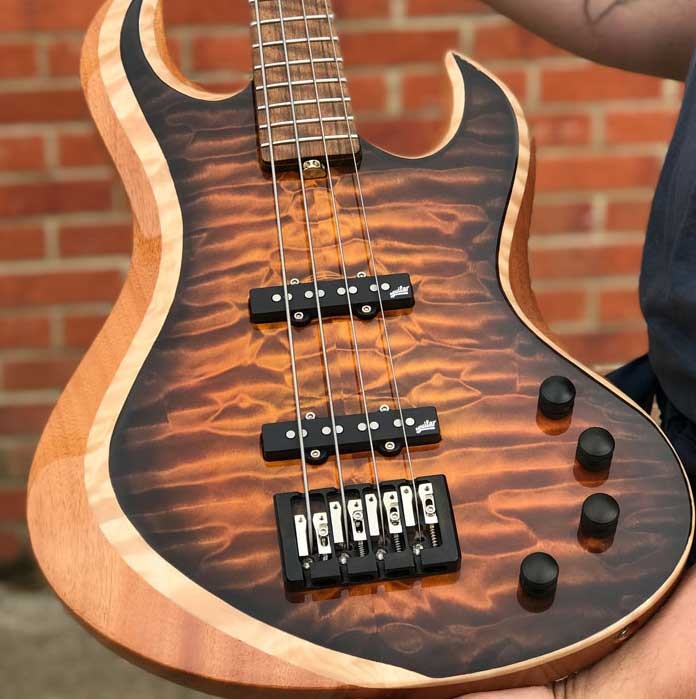Note up front: Carving a neck is largely about feel rather than process; this is not something that can be described as a 1-2-3 method, nor would we even attempt to.
Neck carving is a fundamental reason why luthiery schools exist, and is best learned in that style of environment. However, we will do our best to give you a general overview of what is involved.
At this point our neck blank is still a rectangular block of wood.
Tools


The carving tool of choice is a half round file, the same as the automotive tool.
The blade is available generally as a Stanley Surform Half Round blade (seen above as the blade shown at bottom.)
It is not necessary to house the blade in a holder, as said holder would do nothing more than get in the way. Preventing hand injury from the blade is easily done by wrapping the blade ends in masking tape. You can also wear gloves if desired.
Technique
The best way to describe this is that you will be carving a series of facets into the neck. At this point the blank is a block, and you will be first cutting two long facets down the length of the board, similar to if you were shaping one side of a hexagon. These sides you create will be divided again and then again until the end result shape is round-ish.
This is called a “round-ish” shape because ultimately, to achieve proper smoothness, this is where hand sanding comes into effect, which we will describe later on.
Heel end of neck
For carving this part of the neck, a more curved file is desirable for easier shaping. Generally speaking, a rasp file should get the job done here.
You will notice that there are several varieties of rasp files available. If unsure which to go with, the double-radiused sizes (both fine and coarse) would be the ones to get; you can see these in the photo above.
When shaping the heel of the neck, you would ordinarily start with the coarse file, then move on to the fine file to smooth until you have both the desired shape and feel you’re looking for.
Other tools needed
10-inch Planer Saw Rasp
The purpose of this saw is to make a flat surface. The advantages of using this particular saw is that it is held in an offset position, which is good for neck shaping use.
An example of this tool is shown in the above photo at top; it is the largest tool seen with the red handle. You can typically find this tool on Amazon and other places for sale as a “Shinto Planer Saw Rasp”.
Additional shaping method: “Shoeshine” sanding
In the end process of a traditional old-school shoeshine, a cloth is draped over the shoe and pulled back and forth to finalize the shine. A similar process is used on the backside of the neck to smooth the neck, except instead of cloth, sandpaper would be used, usually an 80 grit strip. The above photo shows the style of sandpaper used at bottom right.




Handy hint – mount a Luxo lamp (double-jointed arm) so you can position it low to the workbench and move it along as you carve. It will throw a sharp shadow line that will instantly show up any hollow or lump in your carving. Also, it’s important to make sure each facet is smooth, no dips or bumps, before you go on the next facet. This will keep you in control of the neck’s smooth roundness.
RR
A good file for neck shaping is the 14″ single cut ( 8 teeth per inch) body file. Available from many online sources between 25 and 60 dollars, dependent on brand.
This file is dead flat and acts more like 112 micro planes than a file in action, but removes immense amounts of wood quickly, with less drama than a round or half round profile surform styles.
It can also be used inline with the neck and keep the lines of the facets very flat.
The half and full round files files have there place at the head and heel but for long flat sections the body file is my preference.
As with the surform files you must be aware of the grain and always work to lay the grain down with the cuts rather than raise the grain and tear it, as with using a plane.
Be careful this file is extremely sharp and will remove skin from your fingers quicker than the material from the neck if you have not taken due care.
PB
The 14 ” 9 8 teeth per inch) body file, available from any auto body sources, is a good file for neck shaping.
This file is dead flat and removes material extremely quickly as it works as 112 planes.
As with the Surform and a regular plane you must be grain aware and lay the grain down as you work else you will tear huge chunks out of the neck.
The advantage of this file is you can work inline with the neck and remove any ridges quickly and flatten the facets quickly.
Be very careful as this plane will also tear the skin from your fingers quicker than the wood from your neck.
The half round files have there place at the head and heel and work well for these locations but for the actual neck a flat profile is best.
PB
I am considering modifying/building a bass and was interested if anyone had any thoughts on using blackthorn for the neck.